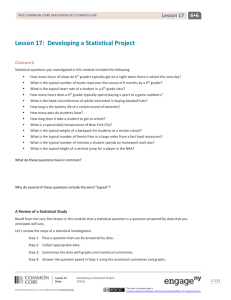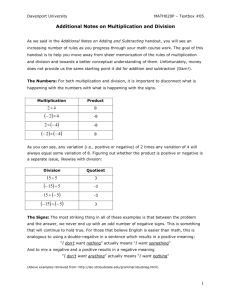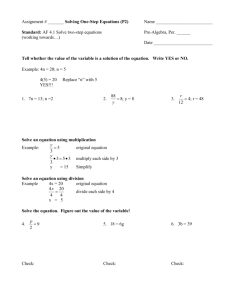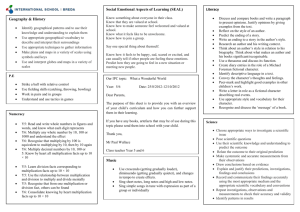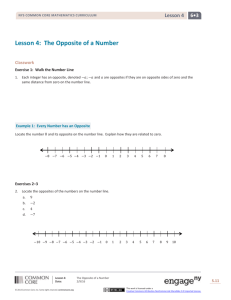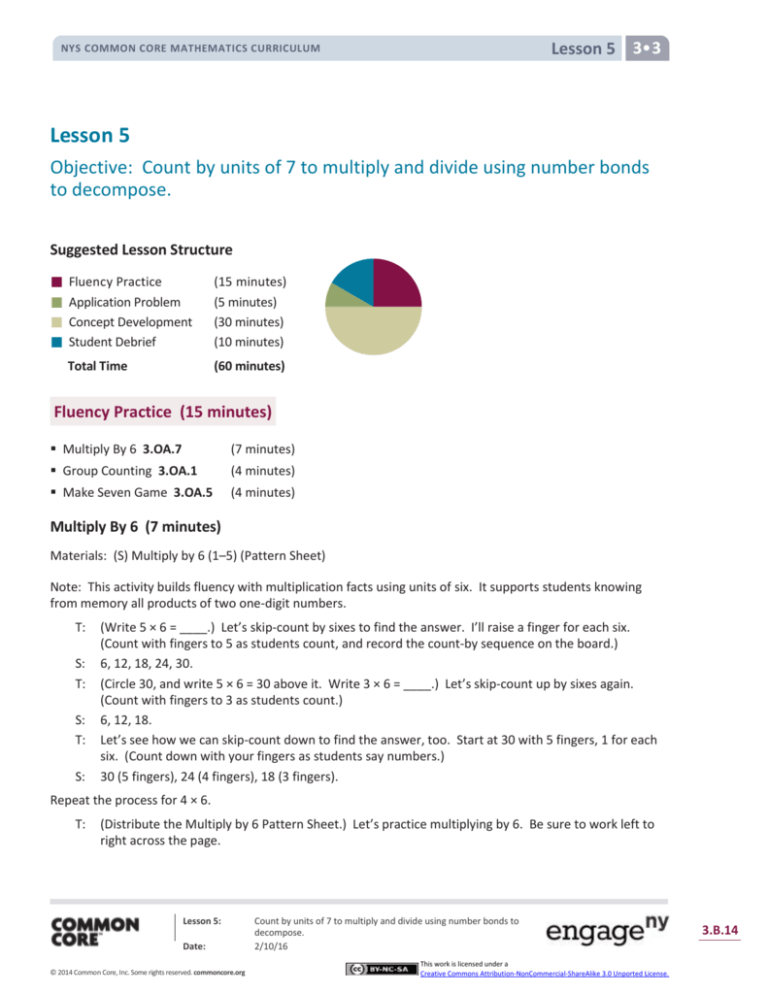
Lesson 5 3•3
NYS COMMON CORE MATHEMATICS CURRICULUM
Lesson 5
Objective: Count by units of 7 to multiply and divide using number bonds
to decompose.
Suggested Lesson Structure
Fluency Practice
Application Problem
Concept Development
Student Debrief
Total Time
(15 minutes)
(5 minutes)
(30 minutes)
(10 minutes)
(60 minutes)
Fluency Practice (15 minutes)
Multiply By 6 3.OA.7
(7 minutes)
Group Counting 3.OA.1
(4 minutes)
Make Seven Game 3.OA.5
(4 minutes)
Multiply By 6 (7 minutes)
Materials: (S) Multiply by 6 (1–5) (Pattern Sheet)
Note: This activity builds fluency with multiplication facts using units of six. It supports students knowing
from memory all products of two one-digit numbers.
T:
S:
T:
S:
T:
S:
(Write 5 × 6 = ____.) Let’s skip-count by sixes to find the answer. I’ll raise a finger for each six.
(Count with fingers to 5 as students count, and record the count-by sequence on the board.)
6, 12, 18, 24, 30.
(Circle 30, and write 5 × 6 = 30 above it. Write 3 × 6 = ____.) Let’s skip-count up by sixes again.
(Count with fingers to 3 as students count.)
6, 12, 18.
Let’s see how we can skip-count down to find the answer, too. Start at 30 with 5 fingers, 1 for each
six. (Count down with your fingers as students say numbers.)
30 (5 fingers), 24 (4 fingers), 18 (3 fingers).
Repeat the process for 4 × 6.
T:
(Distribute the Multiply by 6 Pattern Sheet.) Let’s practice multiplying by 6. Be sure to work left to
right across the page.
Lesson 5:
Date:
© 2014 Common Core, Inc. Some rights reserved. commoncore.org
Count by units of 7 to multiply and divide using number bonds to
decompose.
2/10/16
This work is licensed under a
Creative Commons Attribution-NonCommercial-ShareAlike 3.0 Unported License.
3.B.14
Lesson 5 3•3
NYS COMMON CORE MATHEMATICS CURRICULUM
Directions for administration of Multiply By Pattern Sheets:
Distribute Multiply By Pattern Sheets.
Allow a maximum of two minutes for students to complete as many problems as possible.
Direct students to work left to right across the page.
Encourage skip-counting strategies to solve unknown facts.
Group Counting (4 minutes)
Note: Group counting reviews interpreting multiplication as repeated addition. Counting by sevens prepares
students for multiplication using units of seven in this lesson. Group counting by eights and nines anticipates
multiplication using those units later in the module. Direct students to count forward and backward,
occasionally changing the direction of the count:
Sevens to 70
Eights to 80
Nines to 90
Make Seven Game (4 minutes)
Materials: (S) Set of playing cards numbered 1─6
Note: This activity prepares students for the skip-counting strategy used to multiply units of seven in today’s
lesson.
Students play in pairs. Each pair has a set of six cards, each with a number 1–6.
T:
T:
S:
(Write ___ + ___ = 7.) Spread the cards out in front of you.
Put your hands behind your back. I’ll write a number in the first blank. When you know the number
that belongs in the second blank, touch the card that shows the number. The first person to touch
the card keeps it. Whoever has the most cards at the end wins. (Write 5 + __ = 7.)
(Touch the 2 card. The first to touch it keeps the card.)
Continue with the following suggested sequence: 1, 4, 2, 3, and 6.
Application Problem (5 minutes)
Gracie draws 7 rows of stars. In each row, she draws 4 stars.
How many stars does Gracie draw in all? Use a letter to
represent the unknown and solve.
Note: This problem reviews the G3–Module 1 concept of
multiplying using units of four. It will be used in the Concept
Development to lead into skip-counting by sevens. Be sure to
circulate and find a student’s answer to use as an example in
the Concept Development (find a student who counted by four
7 times to solve the problem).
Lesson 5:
Date:
© 2014 Common Core, Inc. Some rights reserved. commoncore.org
Count by units of 7 to multiply and divide using number bonds to
decompose.
2/10/16
This work is licensed under a
Creative Commons Attribution-NonCommercial-ShareAlike 3.0 Unported License.
3.B.15
Lesson 5 3•3
NYS COMMON CORE MATHEMATICS CURRICULUM
Concept Development (30 minutes)
Materials: (S) Personal white board
Part 1: Use number bonds to decompose and make ten as a
strategy for skip-counting units of 7.
T:
S:
T:
T:
S:
T:
S:
T:
T:
T:
S:
T:
S:
T:
T:
S:
I noticed that Student A solved the Application
Problem by skip-counting by four 7 times. Is there
another count-by strategy that could be used to solve
this problem?
Skip-count by seven 4 times.
Let’s show that work on our boards. Write 7 on your
board.
How do we get the next number in our count?
Add 7!
Can we use a number bond to add 7 by making ten like
we did with sixes?
Yes, we can break apart 7 into 3 and 4, and then use
the 3 to make ten with the first 7.
Work with a partner to use number bonds to show
how you make ten to count by seven 4 times.
Check your work with mine. (Project work as shown.)
What is the last number in the sequence when you
count by seven 4 times?
28!
Is the answer the same even though Student A counted
by four 7 times?
Yes, it’s the same because we just switched the order
of the factors. The product is the same, but the
order of the factors is different. It’s the commutative
property.
Work with a partner to complete your sequence by
counting by seven 10 times. Use number bonds to
make ten. (Circulate and check student work.)
Everyone, at my signal, read your count by seven
sequence.
7, 14, 21, 28, 35, 42, 49, 56, 63, 70.
Lesson 5:
Date:
© 2014 Common Core, Inc. Some rights reserved. commoncore.org
NOTES ON
MULTIPLE MEANS
OF REPRESENTATION:
For English language learners, preteach and/or clarify unfamiliar math
terms such as sequence, row, factors,
product, number bond, count by, and
skip-count.
Depending on your learners’ needs,
give explicit prompts for every step of
the make ten strategy to count by
seven 4 times. Alternatively, you may
scaffold with a checklist or template.
Count by seven 4 times:
Remaining count by seven:
Count by units of 7 to multiply and divide using number bonds to
decompose.
2/10/16
This work is licensed under a
Creative Commons Attribution-NonCommercial-ShareAlike 3.0 Unported License.
3.B.16
Lesson 5 3•3
NYS COMMON CORE MATHEMATICS CURRICULUM
Part 2: Skip-count by seven to solve multiplication and division problems.
T:
T:
S:
T:
S:
T:
S:
T:
Let’s use our sequence to solve multiplication and
division problems with seven. I am going to say a
NOTES ON
multiplication or division problem. Write the problem
MULTIPLE MEANS
on your personal white board and use your sequence
to find the answer. At my signal, show your board.
OF ENGAGEMENT:
Some learners may prefer to use the
Let’s do a practice one together. Turn and talk to a
distributive or commutative property
partner. How can you use your skip-counting sequence
to solve 7 times 6. Encourage their
to solve 42 divided by 7?
personal choices of efficient strategies.
I can count 6 sevens in the sequence, which takes me
Challenge learners to present a
to 42. So, 42 divided by 7 equals 6.
multiplication fact they would solve
Write the equation on your board.
using skip-counting. Ask, “How do you
choose your strategy to solve?”
(Write 42 ÷ 7 = 6.)
At my signal, show me your board. (Signal.)
(Show board.)
Okay, here we go, next problem! 49 divided by 7 equals…? (After students work, signal.)
Continue with the following suggested sequence:
7×6
7 × e = 56
f ÷ 7 equals 9
Problem Set (10 minutes)
Students should do their personal best to complete the
Problem Set within the allotted 10 minutes. For some
classes, it may be appropriate to modify the assignment by
specifying which problems they work on first. Some
problems do not specify a method for solving. Students
should solve these problems using the RDW approach
used for Application Problems.
Lesson 5:
Date:
© 2014 Common Core, Inc. Some rights reserved. commoncore.org
Count by units of 7 to multiply and divide using number bonds to
decompose.
2/10/16
This work is licensed under a
Creative Commons Attribution-NonCommercial-ShareAlike 3.0 Unported License.
3.B.17
Lesson 5 3•3
NYS COMMON CORE MATHEMATICS CURRICULUM
Student Debrief (10 minutes)
Lesson Objective: Count by units of 7 to multiply and
divide using number bonds to decompose.
The Student Debrief is intended to invite reflection and
active processing of the total lesson experience.
Invite students to review their solutions for the Problem
Set. They should check work by comparing answers with a
partner before going over answers as a class. Look for
misconceptions or misunderstandings that can be
addressed in the Debrief. Guide students in a
conversation to debrief the Problem Set and process the
lesson.
You may choose to use any combination of the questions
below to lead the discussion.
MP.5
Take turns with a partner reading the
multiplication facts in Problem 1 and the related
division facts.
How can you use number bonds to help you solve
Problem 2?
What are some different strategies that can help you solve multiplication facts using units of seven?
How do you choose your strategy to solve?
In Problem 3, would it make sense for Abe to use number bonds to find the next number after 21 in
the count by seven sequence? Why or why not?
How does counting by seven help you solve multiplication and division problems with seven?
How does Problem 4 demonstrate the commutative property?
How does today’s lesson relate to our previous work of adding 1 unit to 5 units?
Exit Ticket (3 minutes)
After the Student Debrief, instruct students to complete the Exit Ticket. A review of their work will help you
assess the students’ understanding of the concepts that were presented in the lesson today and plan more
effectively for future lessons. You may read the questions aloud to the students.
Lesson 5:
Date:
© 2014 Common Core, Inc. Some rights reserved. commoncore.org
Count by units of 7 to multiply and divide using number bonds to
decompose.
2/10/16
This work is licensed under a
Creative Commons Attribution-NonCommercial-ShareAlike 3.0 Unported License.
3.B.18
NYS COMMON CORE MATHEMATICS CURRICULUM
Lesson 5 Pattern Sheet 3•3
Multiply.
multiply by 6 (1–5)
Lesson 5:
Date:
© 2014 Common Core, Inc. Some rights reserved. commoncore.org
Count by units of 7 to multiply and divide using number bonds to
decompose.
2/10/16
This work is licensed under a
Creative Commons Attribution-NonCommercial-ShareAlike 3.0 Unported License.
3.B.19
Lesson 5 Problem Set 3•3
NYS COMMON CORE MATHEMATICS CURRICULUM
Name
Date
1. Skip-count by seven to fill in the blanks in the fish bowls. Match each count-by to its multiplication
expression. Then, use the multiplication equation to write the related division fact directly to the right.
7
7×6
_______ ÷ 7 = _______
7×3
_______ ÷ 7 = _______
7×8
_______ ÷ 7 = _______
7×7
_______ ÷ 7 = _______
7×1
_______ ÷ 7 = _______
7×5
_______ ÷ 7 = _______
7×9
_______ ÷ 7 = _______
7×4
_______ ÷ 7 = _______
7×2
_______ ÷ 7 = _______
______
21
______
______
42
49
______
______
Lesson 5:
Date:
© 2014 Common Core, Inc. Some rights reserved. commoncore.org
Count by units of 7 to multiply and divide using number bonds to
decompose.
2/10/16
This work is licensed under a
Creative Commons Attribution-NonCommercial-ShareAlike 3.0 Unported License.
3.B.20
NYS COMMON CORE MATHEMATICS CURRICULUM
Lesson 5 Problem Set 3•3
2. Complete the count-by seven sequence below. Then, write a multiplication equation and a division
equation to represent each blank you filled in.
7, 14, _______, 28, _______, 42, _______, _______, 63, _______
a. _______ × 7 = _______
_______ ÷ 7 = _______
b. _______ × 7 = _______
_______ ÷ 7 = _______
c. _______ × 7 = _______
_______ ÷ 7 = _______
d. _______ × 7 = _______
_______ ÷ 7 = _______
e. _______ × 7 = _______
_______ ÷ 7 = _______
3. Abe says 3 × 7 = 21 because 1 seven is 7, 2 sevens are 14, and 3 sevens are 14 + 6 + 1, which equals 21.
Why did Abe add 6 and 1 to 14 when he is counting by seven?
4. Molly says she can count by seven 6 times to solve 7 × 6. James says he can count by six 7 times to solve
this problem. Who is right? Explain your answer.
Lesson 5:
Date:
© 2014 Common Core, Inc. Some rights reserved. commoncore.org
Count by units of 7 to multiply and divide using number bonds to
decompose.
2/10/16
This work is licensed under a
Creative Commons Attribution-NonCommercial-ShareAlike 3.0 Unported License.
3.B.21
NYS COMMON CORE MATHEMATICS CURRICULUM
Name
Lesson 5 Exit Ticket 3•3
Date
Complete the count-by seven sequence below. Then, write a multiplication equation and a division equation
to represent each number in the sequence.
7, 14, _______, 28, _______, 42, _______, _______, 63, _______
a. _______ × 7 = _______
_______ ÷ 7 = _______
b. _______ × 7 = _______
_______ ÷ 7 = _______
c. _______ × 7 = _______
_______ ÷ 7 = _______
d. _______ × 7 = _______
_______ ÷ 7 = _______
e. _______ × 7 = _______
_______ ÷ 7 = _______
f.
_______ × 7 = _______
_______ ÷ 7 = _______
g. _______ × 7 = _______
_______ ÷ 7 = _______
h. _______ × 7 = _______
_______ ÷ 7 = _______
i. _______ × 7 = _______
_______ ÷ 7 = _______
j. _______ × 7 = _______
_______ ÷ 7 = _______
Lesson 5:
Date:
© 2014 Common Core, Inc. Some rights reserved. commoncore.org
Count by units of 7 to multiply and divide using number bonds to
decompose.
2/10/16
This work is licensed under a
Creative Commons Attribution-NonCommercial-ShareAlike 3.0 Unported License.
3.B.22
NYS COMMON CORE MATHEMATICS CURRICULUM
Name
Lesson 5 Homework 3•3
Date
1. Use number bonds to help you skip-count by seven by making ten or adding to the ones.
10 + ______
4
a. 7 + 7 = ______
= _______
3
4
b. 14 + 7 = ______ + ______ = _______
6
1
c. 21 + 7 = ______ + ______ = _______
20 1
d. 28 + 7 = ______ + ______ = _______
2
5
e. 35 + 7 = ______ + ______ = _______
5
f.
2
42 + 7 = ______ + ______ = _______
g. 49 + 7 = ______ + ______ = _______
h. 56 + 7 = ______ + ______ = _______
Lesson 5:
Date:
© 2014 Common Core, Inc. Some rights reserved. commoncore.org
Count by units of 7 to multiply and divide using number bonds to
decompose.
2/10/16
This work is licensed under a
Creative Commons Attribution-NonCommercial-ShareAlike 3.0 Unported License.
3.B.23
NYS COMMON CORE MATHEMATICS CURRICULUM
Lesson 5 Homework 3•3
2. Skip-count by seven to fill in the blanks. Then, fill in the multiplication equation and use it to write the
related division fact directly to the right.
_____
7 × 10 = _____
_______ ÷ 7 = _______
_____
7 × 9 = _____
_______ ÷ 7 = _______
7 × 8 = _____
_______ ÷ 7 = _______
7 × 7 = _____
_______ ÷ 7 = _______
7 × 6 = _____
_______ ÷ 7 = _______
7 × 5 = _____
_______ ÷ 7 = _______
_____
49
_____
_____
_______ ÷ 7 = _______
28
7 × 4 = _____
_____
7 × 3 = _____
_____
7 × 2 = _____
_______ ÷ 7 = _______
7
7 × 1 = _____
_______ ÷ 7 = _______
_______ ÷ 7 = _______
Lesson 5:
Date:
© 2014 Common Core, Inc. Some rights reserved. commoncore.org
Count by units of 7 to multiply and divide using number bonds to
decompose.
2/10/16
This work is licensed under a
Creative Commons Attribution-NonCommercial-ShareAlike 3.0 Unported License.
3.B.24

